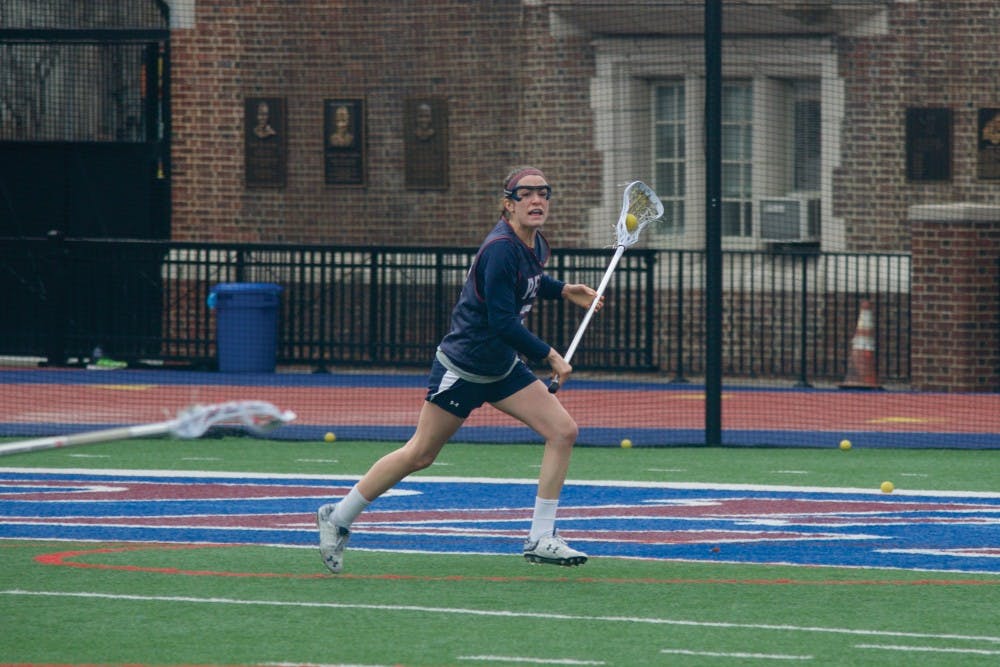In order to completely change the culture of any group, the first step is to start from within. And for a Penn Athletics brand looking to reignite its formerly passionate fan base, the road to remodeling is underway.
The athletic department has made strides to promote a support system among its varsity teams thanks to the efforts of first-year Senior Associate Athletic Director Sherryta Freeman. Starting the “Quaker Cup” competition this year, Penn Athletics has pitted its varsity teams against one another to determine the most actively supportive athletes on campus.
“It was an initiative we talked with our Student-Athlete Advisory Committee about to just kind of add a little bit of flavor to what they’re already doing to increase the attendance and some of the spirit among our student-athletes,” Freeman said. “We decided, ‘Hey, let’s give it a shot,’ and we’ve seen a lot of excitement.”
In this contest, each of Penn’s varsity teams is scored based on their team grade point average, game results, community service engagement and attendance of other teams’ events, among other factors.
As of April 4, field hockey is the competition’s overall leader with 767.50 points, with women’s lacrosse in a close second place at 742.76.
“I think that our team has been able to do well with the Quaker Cup because we have friends on other teams and supporting those friends is, at least from most of our points of view, the main reason we go,” women’s lacrosse midfielder Lauren D’Amore said. “But the points system kind of becomes a good way to draw in other girls on the team to go to games.”
Efforts to raise student interest in athletics are nothing new, but the innovative thinking of Freeman and the SAAC to institute an aspect of competition seems to be paying off so far. Understanding that Division I athletes are an inherently competitive group, Penn Athletics has worked this to its advantage.
“It’s a really good idea to incentivize student-athletes to go to each other's sporting events and to encourage more of those connections across teams to be made, so we really like it,” D’Amore said.
Strictly for Penn’s flagship programs, the raw numbers might not show a significant increase in fan passion. Football averaged 6,048 fans per home game in 2015, a decrease of more than 2,500 from 2014. Men’s basketball saw a marginal jump from 3,141 fans per game in 2014-15 to 3,214 this season, but that still was the school’s second lowest mark since 1992.
Even for women’s basketball — which completed a remarkable 24-5 season culminating in Penn’s fourth ever NCAA Tournament appearance — the school couldn’t muster enough interest to justify a fan bus to the team’s first round loss to Washington in College Park, Md. (although the game being played on Saturday of St. Paddy’s weekend couldn’t have helped).
But if one looks deeper, the signs of a revolution are there. Aided by the usage of Penn Rewards — an application started in the 2012-13 academic school year that offers prizes to students based on their attendance of athletic events — more heads have popped into the stands for Penn’s lesser known programs. As a result, national champions like senior Chris Swanson (men’s swimming, 1650-yard freestyle) and senior Sam Mattis (men’s track and field, discus) no longer showcase their abilities in silence.
“For what we wanted to do in terms of getting students out to events that they maybe haven’t been to, I think we’ve been able to do that,” Freeman said. “We’ve had student-athletes out to races on the river for crew, going to watch throwing events for track and field, so in some respects, we’ve helped expose people to events that maybe they would never have gone to.”
Additionally, while the benefits to the athletes in the stands are fairly obvious given the scoring system, the boosts that a lively crowd can provide to those on the field should not be underestimated.
“It’s really important to have fans there, especially given that we need to win the rest of our Ivy games,” said D’Amore, whose team is just 1.5 games out of first place in the Ancient Eight behind Princeton. “The more, the merrier, so if [the competition] gets fans to come out, it’s a great solution.”
Needless to say, no empire is built overnight, and Penn Athletics still has work to do to restore fan interest to the levels of the department’s glory days.
But with an innovative staff working to find clever ways to buck the overarching trend of student apathy, the ball is rolling for the transformation of the culture to continue.
“At the end of the year, we’ll talk with all of our teams and we’ll talk with SAAC for feedback on how we did and what we could do better and try to make some of those changes next year,” Freeman said.
“But I think we’ll definitely have some version of the Quaker Cup for the near future.”



